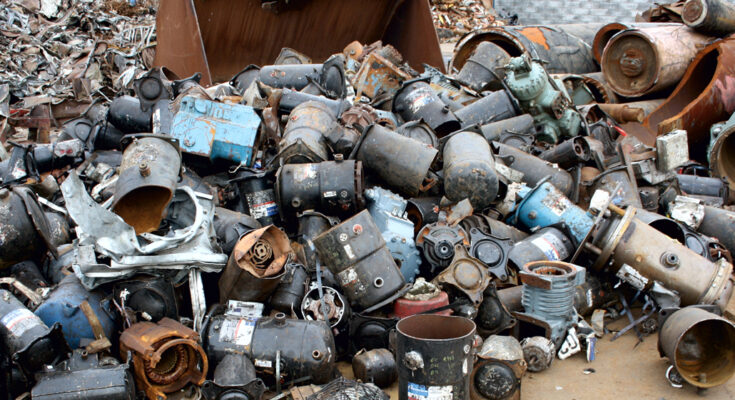In a world where environmental sustainability has taken center stage, the recycling and reusing of unwanted metallic materials, particularly scrap metal, have become crucial pillars of responsible resource management. This article delves into the importance of recycling scrap metal, the various methods involved, and the profound impact it has on both the environment and the economy.
Understanding the Significance of Scrap Metal Recycling
Scrap metal, often overlooked, holds immense potential in our quest for a greener, more sustainable future. Here’s why recycling scrap metal matters:
- Resource Conservation: Recycling scrap metal significantly reduces the demand for fresh mining and ore extraction, conserving our planet’s finite natural resources. For instance, recycling steel saves approximately 74% of the energy required to produce it from raw materials.
- Energy Efficiency: Manufacturing products from recycled scrap metal consumes considerably less energy compared to using virgin materials. This reduction in energy consumption directly translates into reduced greenhouse gas emissions and a lighter carbon footprint.
- Waste Reduction: Metals, including scrap metal, are non-biodegradable. When improperly disposed of in landfills, they can pose long-term environmental hazards. Recycling diverts these materials from landfills, extending their usefulness and mitigating environmental harm.
Methods of Scrap Metal Recycling
The journey of scrap metal from discarded items to valuable resources involves several key steps:
- Collection: The first stage in scrap metal recycling is the collection of unwanted metallic materials. This can encompass a wide range, from old appliances and vehicles to construction materials and even discarded household items.
- Sorting: Once collected, scrap metal materials are carefully sorted based on their type. Advanced techniques, including magnets and sensors, aid in separating ferrous (iron-based) metals from non-ferrous metals such as aluminum and copper.
- Processing: After sorting, the materials undergo thorough cleaning and processing to eliminate any contaminants, like paint, plastic, or insulation. This prepares the scrap metals for the crucial step of melting and reshaping.
- Melting: The cleaned scrap metals are then subjected to high-temperature furnaces, where they are melted down to create metal ingots or other malleable forms. These can be used in various industries to manufacture a wide range of products, from automotive parts to packaging materials.
Environmental and Economic Benefits of Scrap Metal Recycling
Recycling and reusing scrap metal bring about a host of environmental and economic advantages:
- Reduced Environmental Impact: Recycling scrap metal significantly reduces the environmental impact associated with mining and refining virgin materials. It curtails energy consumption, lowers greenhouse gas emissions, and minimizes the ecological footprint of resource extraction.
- Job Creation: The scrap metal recycling industry generates employment opportunities across various stages, from collection and processing to manufacturing. This contributes to economic growth and stability.
- Energy Savings: Recycling metals consumes less energy than producing new materials from scratch. This translates to cost savings for manufacturers and reduced energy-related emissions.
- Sustainable Resource Management: By relying on recycled materials like scrap metal, countries can decrease their dependence on imported raw metals, promoting economic self-sufficiency and responsible resource management.
Scrap Metal Recycling Trends and Innovations
The field of scrap metal recycling is continuously evolving, embracing innovative technologies and practices to enhance sustainability further:
- Advanced Sorting Technologies: Emerging technologies like laser-induced breakdown spectroscopy (LIBS) and artificial intelligence-based sorting systems are revolutionizing metal sorting. These advancements improve accuracy and efficiency in the separation of different metals.
- Urban Mining: Urban mining involves the recovery of metals from discarded electronic devices such as smartphones and laptops. This approach reduces the need for traditional mining and encourages the recycling of valuable metals found in electronic waste.
- Circular Economy Initiatives: The concept of a circular economy promotes the reuse, refurbishment, and recycling of products and materials, including metals. It aims to minimize waste generation and maximize resource efficiency, aligning closely with scrap metal recycling principles.
- Design for Recycling: Manufacturers are increasingly designing products with recycling in mind. They prioritize the use of fewer mixed materials and components that are easily separable, making recycling processes more efficient and cost-effective.
Challenges in Scrap Metal Recycling
While the benefits of scrap metal recycling are substantial, the industry faces several challenges:
- Contamination: Contaminants such as paint, coatings, and adhesives can complicate the recycling process. Efficient removal of these contaminants is crucial for maintaining the integrity of recycled materials.
- Collection Infrastructure: Establishing and maintaining efficient collection systems is essential to ensure the proper gathering and directing of metallic materials to recycling facilities.
- Consumer Awareness: Educating the public about the importance of recycling scrap metal and providing accessible recycling options are vital for increasing recycling rates.
Conclusion
Recycling and reusing scrap metal are vital components of sustainable resource management. This eco-conscious practice conserves valuable resources, reduces energy consumption, and mitigates environmental harm. As individuals and industries continue to recognize the importance of scrap metal recycling, we can look forward to a greener, more sustainable future. By supporting recycling initiatives, making environmentally conscious choices, and embracing innovations, we can all contribute to a healthier planet and a more robust economy. In this age of innovation, the scrap metal recycling industry remains at the forefront of global sustainability efforts.




